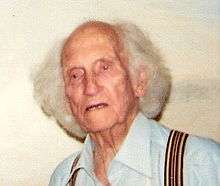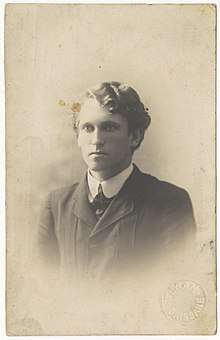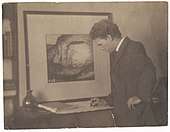Lloyd Rees
Lloyd Frederic Rees AC CMG (17 March 1895 – 2 December 1988) was an Australian landscape painter who twice won the Wynne Prize for his landscape paintings.
Lloyd Rees | |
|---|---|
 | |
| Born | 17 March 1895 |
| Died | 2 December 1988 |
| Nationality | Australian |
| Known for | Painting |
Most of Rees's works are preoccupied with depicting the effects of light and emphasis is placed on the harmony between man and nature. Rees's oeuvre is dominated by sketches and paintings, in which the most frequent subject is the built environment in the landscape.
Life and training
Rees was born in Brisbane, Queensland, the seventh of eight children of Owen Rees and his wife Angèle Burguez,[1] who was half Mauritian, half Cornish.[2][3][4] Rees attended Ironside State School and Ithaca Creek State School in Brisbane's inner west.[5] After formal art training at Brisbane's Central Technical College,[4] he commenced work as a commercial artist in 1917.[1]

Rees was engaged to sculptor Daphne Mayo, but it was broken off in 1925. He married Dulcie Metcalf in 1926. In 1927 Dulcie died in childbirth and Rees married again, in 1931, to Marjory Pollard, mother to his son Alan.[1] Rees' wife died on 14 April 1988 and he died on 2 December of the same year.[6]
From the 1940s until the 1960s Rees was part of the Northwood group, a small group of friends who would go on painting excursions around Sydney Harbor and northwestern Sydney. Regulars of the Northwood group were Lloyd Rees, Roland Wakelin, George Feather Lawrence and John Santry. Douglas Dundas, Wilmotte Williams and Marie Santry also associated with the Northwood group. These artists had no manifesto but were conservative, tending towards a neo-impressionist sinuous style of landscape painting. They were less fashionable than the Sydney abstract expressionism of the time or Melbourne postwar voices of disquiet such as Sidney Nolan.
The studio had a big window, which you passed when walking up the front of the house to the iron gates at the arched entrance. The window was splashed with paint because Lloyd would stand in front of his wet painting holding half a gallon of turps in one hand and put his other hand into the turps and throw it over the painting. As it ran down the painting, washing color with it, he would pick up a cloth and wipe back the selected areas. If you look carefully at his paintings of the eighties you will see where the paint has been handled in this fashion .
— John Santry, John Santry, An Autobiography
Friend and Northwood resident William Pidgeon painted Lloyd Rees portrait which won the 1968 Archibald Prize.[7]
Following Rees's death, Alan Rees and his wife Jancis gave to the Art Gallery of NSW all of Rees's surviving sketchbooks.[8]
Europe

Rees first travelled to Europe in the 1920s (to meet with his then fiancée Daphne Mayo) and made sketches, including many of Paris, which were left accidentally on a bus in London at that time.[9] While some of his works - and indeed his betrothal to Mayo - were lost, his connection with the landscapes of town and country France and Italy was to last a lifetime. Rees visited Europe again in 1953, 1959, 1966–67 and 1973, painting and sketching on all of his journeys.[1]
The sketchbooks are now held by the Art Gallery of New South Wales, comprising approximately 700 images in pencil, carbon pencil, wash, watercolour and ballpoint pen.[8] They reveal a capacity to characterize the texture and light of landscapes in these brief media - concerns that are equally evident in his paintings throughout his career.
Late works
Rees painted right up to his death, by which time he was in his nineties. His works of the last one to two decades in particular showed a preoccupation with the spiritual dimension of the relationship with and portrayal of the landscape, and this became the focus of the final book prepared in cooperation with the author Renée Free: Lloyd Rees: the last twenty years. His late works show an abstraction of form and a focus on the source and effects of light on the landscape, such as in his work The Sunlit Tower, painted when he was 91 years old, and winner of the Jack Manton Prize for 1987 (a prize awarded by the Queensland Art Gallery). He claimed that one of the benefits of his failing eyesight in his old age was that he could look directly at the sun.
Rees's own philosophical views he expressed in the Epilogue to their book:
From quite an early age I was overwhelmed with the fact of endlessness... Planetary systems can blow up, but the universe is endless, and our little life is set in the midst of this, and everything in it has a beginning and an end... [This] gives to life a sense of mystery that is always with me.[10]
Honours
Although Rees's ambition was to be taken seriously as a painter, and was eventually accepted late in life, his paintings were often harshly received by the critics and public. He is seen as a virtuoso in pencil sketches of the landscape and was revered by a younger generation of artists such as the celebrated Australian painter Brett Whiteley.
Rees won the Wynne Prize in 1950 and 1982.[11][12] He also won the Commonwealth Jubilee Art Prize in 1957 and in 1971 he won the John McCaughey Memorial Art Prize and the International Cooperation Art Award.
Rees was appointed a Companion of the Order of St Michael and St George (CMG) in 1978[13] and Australia's highest civilian honour, Companion of the Order of Australia (AC) in 1985.[14]
He was awarded the Médaille de la Ville de Paris in 1987 in honour of his artistic achievements.[15]
For forty years, from 1946 to 1986, Rees taught art with Sydney University's Faculty of Architecture and in 1988 received the Sydney University Union Medal for his contributions to art and the University.[4] In the same year he was named as one of the Australian Bicentennial Authority's Two hundred people who made Australia great.
Collections
- Art Gallery of New South Wales
- Art Gallery of Western Australia
- Darling Harbour Authority
- Parliament House, Canberra
- Australian National Gallery
- Newcastle Region Art Gallery
- Queensland Art Gallery
- Royal Australian College of Physicians
- Tasmanian Museum and Art Gallery
- University of Sydney
- University of Western Australia
- West Australian Institute of Technology
Footnotes
- Art Gallery of New South Wales, Lloyd Rees, the Sketchbooks, 2002, http://www.artgallery.nsw.gov.au/sub/rees/biography.html Archived 13 June 2007 at the Wayback Machine, retrieved July 2007
- National Library of Australia news , Volume 8, 1997
- Jupp, James (October 2001). The Australian People: An Encyclopedia of the Nation, Its People and Their Origins. ISBN 9780521807890.
- Duyker, Edward (2008). "Lloyd Rees remembered". Sydney Alumni Magazine. Sydney University (Autumn): 30–31.
- Free, Renée (2012). "Biography - Lloyd Frederic Rees". Australian Dictionary of Biography. Retrieved 30 January 2018.
- Renée Free and Lloyd Rees, Lloyd Rees: the last twenty years, Craftsman House, Sydney, 1990, p. 171
- "Archibald Prize Archibald 1968 finalist: Lloyd Rees by William Pidgeon". Art Gallery NSW. Retrieved 1 August 2020.
- Hendrik Kolenberg, Lloyd Rees in Europe, Art Gallery of New South Wales, Sydney, 2002, p. 18
- Hendrik Kolenberg, Lloyd Rees in Europe, Art Gallery of New South Wales, Sydney, 2002, pp 10-11
- Renée Free and Lloyd Rees, Lloyd Rees: the last twenty years, Craftsman House, Sydney, 1990, p. 166
- "Wynne Prize". AGNSW prize record. Art Gallery of New South Wales. 1950. Retrieved 10 May 2016.
- "Wynne Prize". AGNSW prize record. Art Gallery of New South Wales. 1982. Retrieved 10 May 2016.
- It's an Honour: CMG
- Commonwealth of Australia, It's an Honour: AC, 1987. Retrieved 24 March 2010.
- National Portrait Gallery, Lloyd Rees From Behind (Max Dupain Archived 29 July 2008 at the Wayback Machine, retrieved July 2007
References
- Edward Duyker, ‘Lloyd Rees: Artist and Teacher’, Arts: The Journal of the Sydney University Arts Association, vol. 30, 2008, pp. 34–53.
- Renée Free, Lloyd Rees, Landsdowne, Melbourne, 1972
- Renée Free and Lloyd Rees, Lloyd Rees: The Last Twenty Years, Craftsman House, Sydney, 1990
- Janet Hawley, 'Lloyd Rees: the final interview', Sydney Morning Herald - Good Weekend Magazine, 15 October 1988
- Lou Klepac, Lloyd Rees Drawings, Australian Artist Editions, Sydney, 1978
- Hendrik Kolenberg, Lloyd Rees in Europe, Art Gallery of NSW, Sydney, 2002
- Lloyd Rees, Peaks and valleys: an autobiography, Collins, Sydney, 1985
External links
- Lloyd Rees at the Art Gallery of New South Wales
- National Gallery of Australia
- Lloyd Rees at Australian Art
- Lloyd Rees: Queensland Art Gallery 1998 exhibition review by Grafico Topico's Sue Smith
- Lloyd Rees "Coming Home" Rockhampton Art Gallery exhibition 1999
- "Explore Lloyd Rees' earliest recorded sketches". Museum of Brisbane. Archived from the original on 23 April 2020.